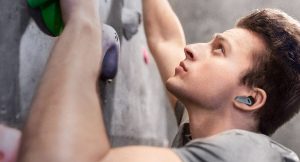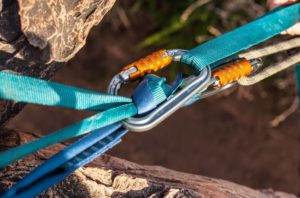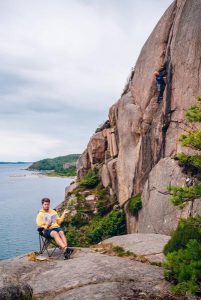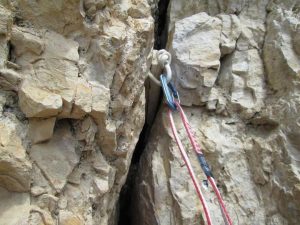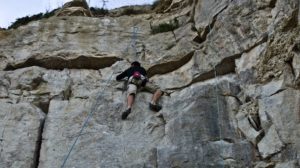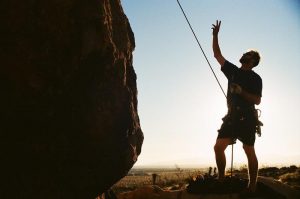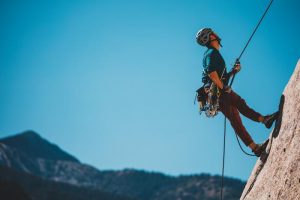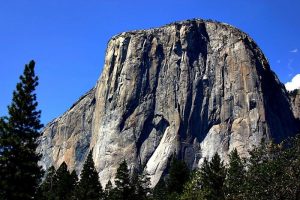Do you wear a climbing helmet every time you rope up? Like most climbers, you probably don’t but know that you should. We’ve evaluated eight of the best and most popular climbing and mountaineering helmets on the market and found some that you will be stoked to strap on every time you climb. We tested four hardshell ABS helmets, three modern lightweight foam helmets and one totally unique helmet with no shell at all. Keep reading to find out which models came out on top.
Best Overall Climbing Helmet: Petzl Meteor
Our top pick goes to the Petzl Meteor, which scored highly in all of our test areas. It earns top scores in comfort and ventilation while being the third lightest helmet of the bunch. This helmet has all of the needed adjustments and a magnetic buckle which allows for one-handed closure, and also integrates fore/aft adjustment with chin strap closure. Its headlamp clips are both quick to use and secure. The most current version of this helmet now comes in two sizes, which better fits women, kids, and small-headed men than the single size of the previous model. We recommend the Meteor for any type of climbing, from the steep sport at the Red River Gorge to steep snow in the Alaska Range.
Best Value: Black Diamond Half Dome
This is at least the third iteration of the Black Diamond Half Dome helmet, and it is certainly the best version yet. This fully loaded helmet has easy to use headlamp clips and a click wheel which allows for one-handed adjustment of the rear band. It is also the most durable helmet we’ve found. At just $60 it is an easy choice for our the Best Buy. This is an excellent choice for new climbers and climbers on a budget looking to get a helmet that will last a long time for minimal coin.
Best Ultralight Helmet: Petzl Sirocco
Our Top Pick Award goes to the super ultralight Petzl Sirocco for being the lightest helmet for climbing currently available. It is also one of the most comfortable helmets we tested, so comfortable in fact, that we sometimes forgot we were wearing it. This helmet is constructed of a single layer of expanded polypropylene rather than polystyrene and has no outer shell. This, along with it’s minimal all textile harness, shave weight but at the expense of durability. This helmet should be reserved for climbers and alpinists looking to shave every possible gram since it does not make a very long-lasting everyday helmet.
Analysis and Review Results
Start by considering what you don’t like about your current helmet or by recounting excuses for not wearing a helmet you’ve used in the past. Look at helmets that score highly in those trouble areas. Never owned or wore a helmet before? Think about what qualities you look for in other parts of your kit. Are you more concerned about weight or durability? Do you want the most bang for your buck or the best product regardless of cost? Either way, we have a helmet recommendation for you.
The first thing you should decide is whether you want a lightweight foam helmet or an ABS hardshell helmet.
Types of Climbing Helmets
The helmets we tested can be broken into two categories: Lightweight Foam and ABS Hardshell.
Lightweight Foam
Lightweight foam helmets are constructed mostly of polystyrene foam covered by a thin shell of polycarbonate plastic which protects the foam. These helmets are lighter, more comfortable, and have better ventilation, but are less durable. We also put the Petzl Sirocco in this category though it is constructed of polypropylene foam and has no outer shell. Other tested helmets in this category are the Petzl Meteor, Black Diamond Vapor, and Black Diamond Vector.
ABS Hardshell
Hardshell helmets consist of a thick outer shell of ABS plastic covering a small chunk of polystyrene foam. The shell is the primary structural component of this type of helmet rather than the foam. These helmets are much heavier than lightweight foam helmets but are more durable due to the thick outer shell. Tested helmets in this category include the Camp Armour, Petzl Elios, Black Diamond Half Dome, and Mammut Skywalker.
Criteria for Evaluation
Comfort
Head shapes vary quite a bit, though maybe not as much as feet. So just like climbing shoes, what fits our testers might not fit you. We tried our test helmets on as many heads as possible, and comfort was usually the first thing that our test subjects commented on. We found that the weight of a helmet is closely linked to overall comfort, just as much as the shape and design of the helmet.
Not surprisingly, our lightest helmet, the Petzl Sirocco, was also the most comfortable. This helmet is hardly perceptible on your head. It’s so light and comfortable that we found ourselves looking for it on the ground twice while we were wearing it. We think that this is a clear sign that it’s a comfortable helmet. This was definitely not the case with the least comfortable helmet, the Mammut Skywalker, which we always knew we had on due to its top-heaviness and clunky rear adjustment band.
If you are one of those climbers who claim they can’t stand wearing a helmet, we think you should get your hands on one of the super light helmets and start there.
Ease of Adjustment
Most of the climbing helmets have a standard adjustment to fit them to your head. These adjustments are chin strap length as well as fore/aft positioning of the strap. All of the helmets we’ve tested have a chin strap that fully releases and is adjustable in length at the release buckle.
Fore/aft adjustment is very important in our opinion. All of the helmets we tested have this adjustment with the exception of the Black Diamond Vapor, which has a fixed chin strap yoke. Front to back positioning of the chins strap is something that is generally done by the user once and then not adjusted again.
All of the helmets we tested have a rear adjustment band of some sort, which tightens against the occipital area and forces the head into the front of the helmet. We found this the single most important adjustment in getting a secure fit. These rear bands range greatly in design, from the super slim, all-textile one found on the Petzl Sirocco to the rigid band adjusted with a large click wheel found on the Black Diamond Half Dome. Essentially all of the bands serve the same purpose, but we found that some were more secure and some were much quicker to adjust. Most of the bands require two hands to adjust, so it is something you aren’t likely to do mid-send on a technical route.
Bands which use click wheels can be adjusted with just one hand though they do add a bit of weight to the helmet. Adjusting the band is also important when switching between a beanie, a headband, or nothing at all underneath the helmet. This is something alpine climbers might do several times a day as temps and activity levels vary.
The quickest and easiest to adjust helmet is the Black Diamond Half Dome which uses a click wheel on the rear band that can be adjusted with just one hand. Just behind that helmet is the Petzl Elios which no longer has a click wheel, but has two large easy to feel buttons on the rear band, though it still requires two hands to tighten, but can be loosened slightly with one finger. The hardest to adjust helmet is the Petzl Sirocco which has an all-webbing band and harness and requires an extra amount of fiddling to get the band in place, though it is secure and very comfortable once in place.
Weight
The helmets in our test ranged in weight from a featherweight 5.8 ounces to 13.7 ounces, which is nearly two and a half times heavier. Ever left one of those behind because you didn’t want the weight? We have.
Helmets like the Petzl Meteor at 7.6 ounces and Black Diamond Vapor at 7.2 ounces are primarily constructed of polystyrene foam covered by a thin shell of polycarbonate and are far lighter than hardshell helmets constructed of thicker ABS plastic. The lightest ABS hardshell helmet we tested is the Petzl Elios, which weighs in at 11.6 ounces. The lightest helmet on the market is the Petzl Sirocco which forgoes any type of shell and is constructed of a single layer of expanded polypropylene foam.
Ventilation
Lack of ventilation is another reason why a lot of climbers dislike wearing a helmet. The more ventilation a helmet has, the better.
We found that lightweight foam helmets have a lot more openings in the shell, and therefore much better ventilation than hardshell helmets. In fact, we gave all of the lightweight foam helmets better ventilation scores than any of the hardshell models. The two best-ventilated helmets are the Black Diamond Vapor and our Editors’ Choice winner, the Petzl Meteor. Both of these helmets have large amounts of open space at the rear and sides of the helmet to allow for cooling airflow.
Headlamp Attachment
The ability to attach a headlamp to a helmet is important. With the exception of one helmet, the method of attaching a headlamp is four clips positioned around the helmet to hold a headlamp strap from sliding upwards. The lone exception was the Petzl Sirocco, which uses two clips in the front of the helmet and an elastic band in the back of the helmet. There were no total fails in this category, and the difference in the ease of use and security of each headlamp’s clips were subtle.
Durability
The most durable lightweight foam helmet was the Petzl Meteor, which is less prone to dings from small impacts than the other thin shelled helmets we tested. The two poorest examples of durability we found were the Petzl Sirocco, which we cracked simply by stuffing in a pack, and the Mammut Skywalker II, which broke before we took it out of the box likely due to vulnerably designed foam.
Conclusion
Helmets have come a long way. Manufacturers are making better, lighter, and more comfortable options for the adventurers of today. The helmets in this review are specific to climbing and are meant to protect your head from falling objects during your vertical pursuits. We hope that this review has helped you to choose the right type of helmet for your climbing needs. Please read our Buying Advice article for more information on the different types that are available.





